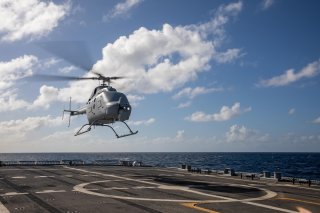The Navy's New MQ-8C Fire Scout has Deployed Aboard USS Milwaukee
The Navy is phasing in the MQ-8C over time to fly alongside and ultimately replace the MQ-8B. The transition is expected to occur over the next several years.
The Navy’s MQ-8C Fire Scout surveillance drone has embarked on its first deployment aboard the Littoral Combat Ship (LCS) USS Milwaukee.
The Milwaukee is operating in the region of U.S. Southern Command. Its MQ-8C has been conducting counter narcotics, identifying targets of interest, and refining surveillance data to prepare for operational deployment, said Capt. Eric Soderberg, MQ-8 Fire Scout program manager, in a press release.
The MQ-8C Fire Scout is a larger, upgraded variant of the existing MQ-8B Fire Scout which now flies from the LCS. The C variant is based on a Bell 407 commercial utility helicopter, but operates high-fidelity maritime sensors that can be used to hunt mines, enemy surface ships, and send real-time video feeds to ships about threats and objects of interest.
While the MQ-8B has performed well with surveillance and mine-hunting missions, the newer MQ-8C brings new advantages such as longer dwell time and expanded capacity reaching beyond the ship’s radar horizon. The MQ-8B operates with up to five hours of “on-station” time, while the MQ-8C expands that to up to twelve hours, Soderberg said.
“With its endurance, it allows the ship to maintain contact which would not be possible with an H-60S (helicopter),” he said.
The MQ-8C will also operate with an upgraded mine-hunting technology called Coastal Battlefield Reconnaissance and Analysis, or COBRA. The MQ-8B incorporates what’s called COBRA Block 1, but the MQ-8C includes the more advanced COBRA Block 2.
“COBRA Block 2 is based upon a (light detection and ranging) system which puts laser energy into the water and measures the returns to determine whether they have a mine or not,” Soderberg said.
The Navy is phasing in the MQ-8C over time to fly alongside and ultimately replace the MQ-8B. The transition is expected to occur over the next several years.
While the upgraded MQ-8C has already been operational for some time, the Navy is deploying it now because it has been outfitted with a new radar system making it much more capable than the MQ-8B it is replacing.
The Navy has been working closely with Northrop Grumman to integrate a maritime radar onto the platform. The drone is also specially configured to work in tandem with MH-60S helicopters, Soderberg said.
Kris Osborn is the Defense Editor for the National Interest. Osborn previously served at the Pentagon as a Highly Qualified Expert with the Office of the Assistant Secretary of the Army—Acquisition, Logistics & Technology. Osborn has also worked as an anchor and on-air military specialist at national TV networks. He has appeared as a guest military expert on Fox News, MSNBC, The Military Channel, and The History Channel. He also has a Master's Degree in Comparative Literature from Columbia University.
Image: U.S. Navy press release.

